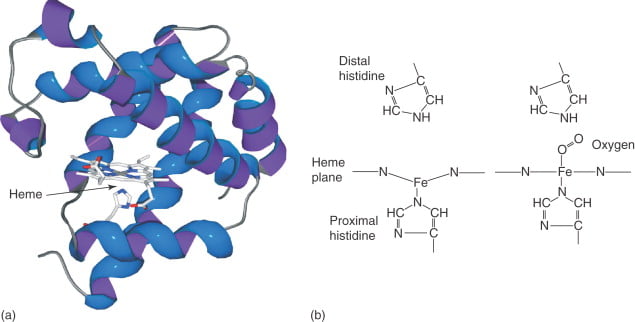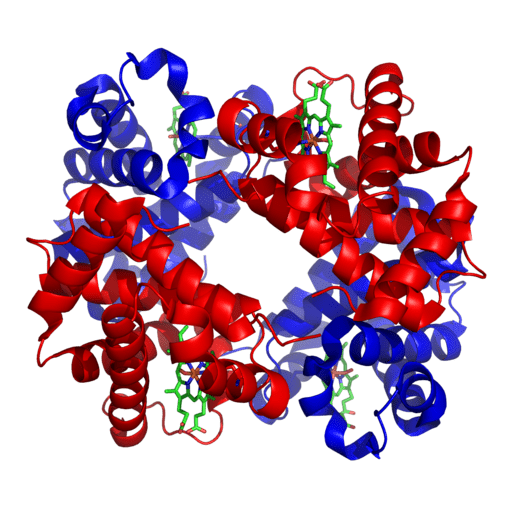What Globular Protein is?
A Globular protein is a Spherical or Globular shaped protein, made by the folding of different segments of a poly-peptide chain. These are the the most abundant proteins in nature. It has a three dimensional structure containing α-helices and β-sheets folded into a compact structure which is stabilized by both polar and non-polar interactions. Such non-covalent molecular attractions are important forces in maintaining the folded conformation of a globular protein.
Key Points :
- A Globular protein is spherical in shape and has the property of forming colloids with water.
- They are held together by weak inter-molecular hydrogen bond.
- They are mostly soluble in water.
- Globular Proteins are also called as spheroproteins with respect to their spherical shape.
- They are sensitive to pH and temperature.
- They are mostly involved in functional role.
Types of Globular Proteins–
- Enzymes:
This type of Globular proteins catalyzes the organic reactions within an organism in mild conditions and with a great specificity.
- Messengers:
Messenger globular proteins transports the messages (cellular/chemical messages) to regulate any biological processes in Eukaryotic multicellular Organisms like Humans just like a postman. This function is mainly done by hormones, i.e. Glucagon, ADH etc.
- Membrane transport proteins:
The Membrane Transport Proteins are a type of globular proteins that transports macromolecules & small molecules across the biological membrane just like a shuttle vehicle.
- Regulatory roles:
Globular proteins also take part in cellular signaling and regulation.
- Structural proteins:
These Proteins e.g., actin and tubulin, which are globular in shape and soluble as monomers, they polymerize to form long & stiff fibers and forms cellular skeleton.
Biological functions of Globular Proteins –
- Hexokinase:
Hexokinase is found in all mammalian tissues. It is one of the regulatory enzyme of Glycolysis. It catalyzes the phosphorylation of glucose by ATP to glucose-6-Phosphate. Mammalian brain tissue shows a high content of Hexokinase Type I which repeats the idea that this isoenzyme is needed to maintain high rates of energy metabolism.
Hexokinase has a low Km and thus it has a high affinity for glucose which allows the initiation of glycolysis even when blood glucose levels are relatively low.

- Insulin:
Insulin is a protein that is composed of 51 Amino Acids and have two chains which are linked by Disulfide Bond. It releases into the capillaries of the islets in response to appropriate stimuli and regulates the level of sugar (glucose) in the blood.
Blood Glucose rises = Insulin Secretion Begin
Blood Glucose falls = Insulin Secretion stops
Insulin also stimulates the transport of glucose and amino acid into muscle cell.

- Hemoglobin:
Hemoglobin is a globular protein with Quaternary structure present on RBCs.
It is the oxygen transporting protein of red blood cells which consists 2 Alpha and 2 Beta chains. Hemoglobin has Iron component that binds with oxygen and then it carries oxygen efficiently from the lungs to the tissues in body.
Mutations and changes in sequence of hemoglobin chain cause change in its structure. This may result in several blood related diseases like sickle cell anemia, a disease where the structure of the RBCs gets distorted and do not have the capacity to carry much oxygen.

- Actin:
Actin is common globular protein that is found in all the eukaryotic cells. It exists in two forms as a free monomer called G-actin or as part of a linear polymer micro-filament called F-actin.
The G-actin is the Globular actin which participates in many important cellular processes including muscle contraction during cell division, cell motility etc. It also helps in maintaining the cell junctions and cell shape.

- Myoglobin:
Myoglobin is a very small globular protein which contains 153 amino acid residues. It is a heme protein which is responsible for the red colour of the muscle.
Myoglobin serves as an intracellular oxygen storage site or local Oxygen reservoir. It can temporarily provide oxygen when blood oxygen delivery is insufficient.

- Membrane Protein
Some globular proteins are anchored in the membrane, these type of globular proteins are called as Membrane Globular Protein.
Some of these serves as Receptors, which are extracellular globular domains that can bind to specific molecules
Some of these acts as a transporters which allows passage of molecules across the membrane.

Other Biological Importance–
Apart from the previous examples, Globular Proteins have more and more important biological functions, such as,
- Transport of ions and molecule. Ex: Hemoglobin, serotonin transporter
- Storage of ion and molecule. Ex: Ferritin
- Muscle contraction. Ex: Myosin
- Hormonal transport and signalling. Ex: Insulin
- Biological Catalyst. Ex: Chymotrypsin
- Defense Mechanism or Immunity – Ex. Antibodies
- Antimicrobial – Lysozyme
Conclusion–
Globular Proteins are functional proteins and plays many biological roles including acting as enzymes, hormones, immunoglobulins, transporting molecules etc.
Denaturation of Globular proteins can cause serious problems and diseases as many important functions will stop.
So from the above examples and previous discussions we can conclude that Globular proteins have a very important role in biological function.
References-
https://en.wikipedia.org/wiki/Globular_protein
https://www.sciencedirect.com/topics/biochemistry-genetics-and-molecular-biology/globular-protein
https://proteopedia.org/wiki/index.php/Globular_Proteins
Principles and Techniques of Biochemistry and Molecular Biology, by Wilson & Walker
Arijit Bhattacharya
Arijit Bhattacharya is pursuing integrated M Tech Biotechnology from KIIT University. He is a Neuroscience enthusiast and He would like to study about cognitive and clinical Neuroscience.
He is also a Sitar player.


